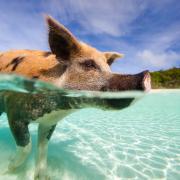Animal magic with the media vet and chef to pets
Hip dysplasia is just one of a range of inherited health conditions affecting companion animals, causing immense suffering to thousands of dogs in the UK. This disease, which is primarily caused by inherited genes, but also affected by factors such as weight and exercise, causes the ball of the hip joint to form in a reduced and irregular shape, and the socket to be much shallower than in a healthy joint. These deformities make the hip joints of affected animals unstable and prone to painful arthritic changes and lead to limited mobility.
The disease is particularly prevalent in certain pedigree breeds, such as the Labrador Retriever, Golden Retriever, Border Collie and German Shepherd, as a result of the years of breeding closely-related dogs for specific physical and temperamental traits. Long-term breeding programmes to create specific types of dogs increase the risks of unwanted genes being selected along with the desirable ones, and this is what has happened over the years with breeds such as the Labrador where the genetic mutations associated with badly-formed hips have become much more common than in the wider dog population.
As treating hip dysplasia is difficult, with complex hip surgery including total hip replacements often being the only effective options that provide long-term results, a lot of research has gone into how we can reduce the incidence or even eradicate the condition entirely. Until recently, the main approach to prevention has been the use of screening programs which use x-rays to identify affected dogs. Dogs shown to have badly formed hips are given a high score and should not be bred from. Since launching in 1965, the UK hip scoring scheme has screened more than 250,000 dogs, from over 180 breeds, and it has undoubtedly played a significant role in gradually decreasing the incidence of the disease. Similar schemes are run for other inherited diseases, including elbow dysplasia and certain eye conditions.

However, despite more than 50 years of screening for hip dysplasia, the disease is still present in many breeding lines around the world. This has led to researchers looking at new ways to tackle the problem, and one of the most interesting is the use of ground-breaking gene-editing technology to correct the genetic mutations linked to the disease.
A team in South Korea, led by Min Kyu Kim, has successfully used the CRISPR gene-editing tool to correct a mutation linked to hip dysplasia in skin cells taken from an affected dog, and then created cloned Labrador puppies that were free of the disease from these edited cells. The puppies, named Gene and Geny, will hopefully grow up to be healthy adults free from the pain of badly-formed hips – but, due to the nature of the gene-editing technique used, they will also have a rather unusual characteristic: along with the corrected hip dysplasia genes, Gene and Geny have also received added genes for a fluorescent protein which means they will glow green under UV light. This won’t cause them any harm at all – but one can imagine that they would cause a bit of a stir at Crufts if the lighting in the show ring included some ultraviolet light!
READ MORE: Advice on choosing the right breed of dog.
Obviously, this approach to dealing with genetic conditions such as hip dysplasia has a long way to go before it will have practical benefits for most dogs, and many people may feel uncomfortable with the idea of genetically-modified pets. However, it’s worth remembering that all of the pedigree dogs in the world have been extensively genetically modified, just using the slower process of selective breeding as opposed to the much faster techniques of genetic engineering. The end result is the same, though – whichever method is used – so I think we need to be prepared to accept that using advanced techniques such as CRISPR gene-editing may well be the best way we can ensure that future generations of companion animals live to enjoy healthy, pain-free lives. Just hopefully without the green glowing part.
Follow Joe on Twitter: @joethevet



























